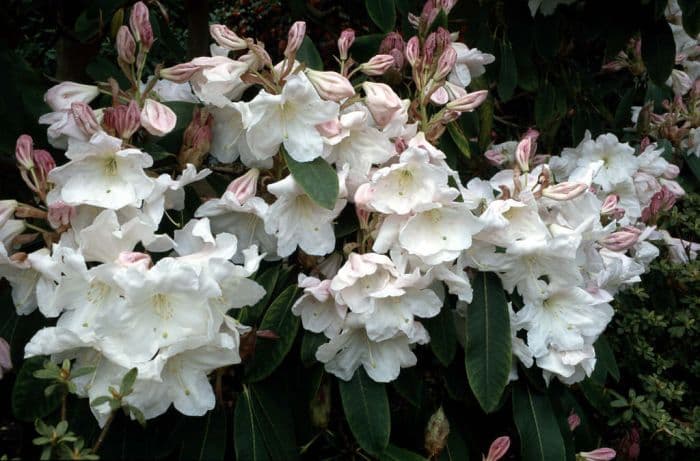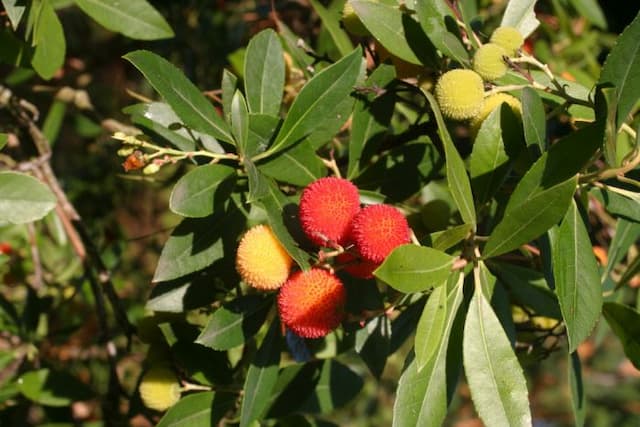Rhododendron Loderi Pink Diamond Rhododendron (Loderi Group) 'Loderi Pink Diamond'

ABOUT
'Loderi Pink Diamond' is a standout variety within the Rhododendron family that is particularly admired for its stunning floral display. The plant showcases large, broad leaves that offer a deep green, glossy backdrop to its flowers. These leaves are evergreen, thus providing year-round interest even when the plant is not in bloom. The real attraction of 'Loderi Pink Diamond' comes in the form of its flowers, which emerge in late spring. The blossoms are large, trumpet-shaped, and arranged in showy clusters that can create a visually striking effect. As the name suggests, the flowers are a soft pink hue with a delicate diamond dusting appearance that can catch the light beautifully, giving the petals a shimmering effect. Each flower exudes a strong, sweet fragrance that can fill the air around the plant, making it a popular choice for planting near outdoor seating areas or along garden paths where its aroma can be fully appreciated by passersby. Overall, 'Loderi Pink Diamond' Rhododendron is a lush, vibrant plant that is especially prized for its fragrant, attractive floral clusters that add a dash of pink and a dynamic aesthetic quality to any garden setting where it is grown.
About this plant
 Names
NamesSynonyms
Rhododendron 'Loderi Pink Diamond', Loderi Pink Diamond Rhododendron.
Common names
Rhododendron 'Loderi Pink Diamond'
 Toxicity
ToxicityTo humans
Rhododendron, including the 'Loderi Pink Diamond', contains toxic compounds known as grayanotoxins. All parts of the plant are considered poisonous if ingested. Symptoms of rhododendron poisoning in humans can include vomiting, diarrhea, drooling, weakness, and depression of the central nervous system. In severe cases, ingestion can result in low blood pressure, coma, and even death from cardiovascular collapse. It is crucial to seek medical help immediately if rhododendron ingestion is suspected.
To pets
Rhododendron poses a similar risk to pets as it does to humans due to the presence of grayanotoxins. Pets, including dogs and cats, may experience symptoms such as vomiting, diarrhea, hypersalivation, weakness, abnormal heart rhythm, and potentially even coma or death if they consume any part of the rhododendron plant. Pet owners should contact a veterinarian immediately if their animal ingests rhododendron.
 Characteristics
CharacteristicsLife cycle
Perennials
Foliage type
Evergreen
Color of leaves
Green
Flower color
Pink
Height
5-8 feet (1.5-2.4 meters)
Spread
5-8 feet (1.5-2.4 meters)
Plant type
Shrub
Hardiness zones
7
Native area
Asia
Benefits
 General Benefits
General Benefits- Aesthetic Appeal: The Rhododendron 'Loderi Pink Diamond' has large, attractive pink flowers that can significantly enhance the visual appeal of gardens and landscapes.
- Seasonal Interest: It blooms prolifically in spring, providing a striking display that adds seasonal interest to outdoor spaces.
- Pollinator Attraction: The flowers attract various pollinators, such as bees and butterflies, contributing to the health of the local ecosystem.
- Versatility in Landscaping: This plant is suitable for a range of landscaping uses, including as a specimen plant, in borders, and in woodland gardens.
- Shade Tolerance: As a woodland species, it is tolerant of partial shade, allowing it to thrive in a variety of garden settings where direct sunlight is limited.
- Evergreen Foliage: It provides year-round interest with its evergreen leaves, ensuring that gardens have a continuous display of greenery.
- Privacy and Screening: The Rhododendron can grow to a substantial size, making it ideal for use as a privacy hedge or to screen unsightly views.
- Sound Barrier: The dense foliage can help to dampen and absorb noise, creating a quieter and more serene garden environment.
- Variety of Sizes and Forms: Available in different sizes and forms, this Rhododendron fits well in both small and large gardens, catering to a variety of landscaping needs.
- Low Maintenance: Once established, it requires minimal care, making it an ideal choice for gardeners of all skill levels.
 Medical Properties
Medical PropertiesThis plant is not used for medical purposes.
 Air-purifying Qualities
Air-purifying QualitiesThis plant is not specifically known for air purifying qualities.
 Other Uses
Other Uses- The thick leaves of Rhododendron can be used as natural insulation material in small-scale projects, like insulating a cold frame for sensitive plants.
- Rhododendron wood, being dense and hard, can be carved into small objects such as buttons, jewelry, or even used in the construction of musical instruments.
- Dried and pressed Rhododendron flowers can be used for botanical art or added to homemade paper for a decorative touch.
- The large leaves can serve as natural wraps for outdoor cooking, imparting a subtle flavor when food is cooked within them over a fire.
- Rhododendron 'Loderi Pink Diamond' could be used in thematic gardens, such as a pink-themed garden, due to its soft pink flowers.
- It can play a part in sensory gardens as the plant releases a fragrance, providing an olfactory experience.
- The plant may be used in education to teach about plant breeding and hybridization due to its background as a hybrid variety.
- Used in landscape photography as a subject or background due to its aesthetic appeal, especially when in full bloom.
- Flowers of the Rhododendron 'Loderi Pink Diamond' could potentially be used as a natural dye for textiles, although this is not a common use.
- The plant can be grown as a living fence or privacy screen due to its relatively large size and dense foliage.
Interesting Facts
 Feng Shui
Feng ShuiThe Rhododendron is not used in Feng Shui practice.
 Zodiac Sign Compitability
Zodiac Sign CompitabilityThe Rhododendron is not used in astrology practice.
 Plant Symbolism
Plant Symbolism- Warning and Caution: Rhododendrons are often associated with caution due to their toxic nature, reminding us to be aware of hidden dangers in beauty.
- Elegance: The 'Loderi Pink Diamond' with its delicate pink flowers represents elegance and sophistication. It symbolizes the graceful aspects of nature and refinement.
- Wealth and Prosperity: The lush blooms and the named variety 'Pink Diamond' can be associated with wealth and prosperity, suggesting opulence and value.
- Achievement and Admiration: Rhododendrons are sometimes seen as a symbol of achievement, with the 'Loderi Pink Diamond' being a particularly admired cultivar, reflecting success in gardening and breeding.
- Survival and Resilience: As rhododendrons are hardy plants capable of thriving in various conditions, they can signify the ability to overcome adversity.
 Water
WaterRhododendrons require consistent moisture, and 'Loderi Pink Diamond' is no exception. Water the plant deeply when the top inch of soil feels dry to the touch, typically about once a week during active growth in spring and summer. In hotter, drier climates, it might need watering twice a week, while in cooler, moist regions, it could be less than once a week. Avoid getting water on the leaves to prevent fungal diseases. It's vital to reduce watering frequency in the fall and minimize it during the winter to reflect the plant's reduced need for moisture, providing only enough to prevent the soil from drying out completely; this might amount to a few gallons every couple of weeks, depending on the climate and weather conditions.
 Light
LightThe 'Loderi Pink Diamond' rhododendron thrives in partial shade with filtered sunlight. A location that provides protection from the intense afternoon sun is ideal, as too much direct sunlight can scorch the leaves. An eastern exposure that offers morning sun and afternoon shade, or underneath high canopy trees that allows dappled sunlight to reach the plant, is ideal.
 Temperature
TemperatureThe 'Loderi Pink Diamond' rhododendron prefers cooler temperatures and can usually handle minimum temperatures down to about 20 degrees Fahrenheit but may suffer damage below this threshold. Ideal growing conditions are in temperatures that remain between 60 and 70 degrees Fahrenheit. The maximum temperature tolerated well by rhododendrons is generally around 80 degrees Fahrenheit, after which they may need additional care to cope with heat stress.
 Pruning
PruningPrune your 'Loderi Pink Diamond' rhododendron to shape the plant, remove dead or diseased wood, and promote air circulation. The best time to prune is immediately after the spring bloom, as rhododendrons set next year's flower buds by mid-summer. Light pruning every year helps maintain the plant's structure, while more extensive pruning should be done sparingly, as the plant recovers slowly from heavy cutting.
 Cleaning
CleaningAs needed
 Soil
SoilThe Rhododendron 'Loderi Pink Diamond' thrives in well-draining, acidic soil with a pH of 4.5 to 6.0. A good soil mix consists of equal parts peat moss, pine bark, and perlite or coarse sand to ensure aeration and drainage.
 Repotting
RepottingRhododendrons like 'Loderi Pink Diamond' are typically slow growing and do not need to be repotted often; every 2 to 3 years is sufficient unless the plant has outgrown its current container and its roots are becoming crowded.
 Humidity & Misting
Humidity & MistingRhododendron 'Loderi Pink Diamond' prefers high humidity levels, ideally between 40-60%. To maintain these conditions outdoors, a sheltered location can help protect from drying winds.
 Suitable locations
Suitable locationsIndoor
Provide bright, indirect light and ensure high humidity.
Outdoor
Plant in dappled shade, shelter from strong winds.
Hardiness zone
7-9 USDA
 Life cycle
Life cycleRhododendron 'Loderi Pink Diamond' begins its life cycle when a seed germinates, typically in a moist, well-drained soil with dappled shade. The seedling stage involves initial root and shoot development, and is followed by the juvenile phase, where the plant develops its characteristic foliage and begins to establish a more extensive root system. As it enters the adult vegetative stage, the plant continues to grow in size and produces more leaves, preparing for the reproductive phase. During the reproductive stage, typically in late spring, it forms bud clusters which bloom into large, fragrant, pink flowers that attract pollinators. After pollination, the flowers develop into seed capsules, which upon maturity, release seeds to perpetuate the life cycle. Lastly, in the senescence stage as the plant ages, growth slows and eventually the plant will die, completing its lifecycle.
 Propogation
PropogationPropogation time
Spring-Early Summer
Propogation: The Rhododendron 'Loderi Pink Diamond', a Loderi Group cultivar, is commonly propagated through semi-hardwood cuttings. This method is favored for its relative simplicity and effectiveness in producing true-to-type plants. To propagate, in late summer, select a healthy, non-flowering shoot and cut a 4 to 6-inch (approximately 10 to 15 cm) length. Strip the leaves from the lower half of the cutting and dip the cut end in rooting hormone powder to encourage root development. The treated cutting should then be inserted into a pot filled with a mixture of peat and perlite, ensuring to provide consistent moisture and indirect light. After a few weeks to months, the cuttings will develop roots and can be potted on as individual plants. This process is widely used among amateur and professional gardeners due to its accessibility and high success rates.









